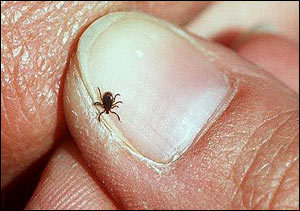How Big is a Tick?
Contrary to popular belief, ticks are not insects but arachnids.  They belong to the same family as mites. They are ectoparasites, meaning they attach themselves to their hosts externally.
They belong to the same family as mites. They are ectoparasites, meaning they attach themselves to their hosts externally.
Ticks are carriers of a number of human diseases, foremost of which is Lyme Disease. Lyme disease is a contagious disease that can affect the brain, heart and central nervous system.
Lyme disease is primarily carried by the tick genus Ixodes scapularis. This is also known as a deer tick and is very common in the United States. Another type that is also known to carry this disease is the Western Black-Legged Tick, scientifically known as Ixodes pacificus.
How Big is a Tick?
There are hundreds of different tick species worldwide and the sizes may vary depending on the type of tick. An adult dog tick for instance may appear to be somewhat like the size of a small grape when engorged, while a deer tick can be so much smaller even when engorged.
Let’s take a look at two of the most common ticks known to carry Lyme Disease: the Deer Tick and the Western Black-Legged Tick.
Deer Tick
The Deer Tick is a very small tick, somewhat resembling one pepper corn. The larva of this tick only measures about one millimeter while the nymphs are only around one millimeter to two millimeters. An adult deer tick is only about 1.4 centimeters.
This tick feeds on its host from 4 to 5 days and then leaves it to prepare herself for laying of eggs. Nymphs and adults of this tick feeds on animals like rats and pets as well as humans.
Western Black-Legged Tick
This tick on the other hand measure about 1/8th of an inch when in its adult stages while the nymphs are approximately 1/16th of an inch, sometimes even less which makes them very hard to notice. You may only notice they are around once you have been bitten.
The nymphs primarily feed on lizards and rats while the adult ticks feed on larger-sized mammals such as horses, cows, deer and humans. The Western Black-Legged Tick is more commonly found in the western parts of the United States hence; its moniker.
Do’s and Don’ts on Tick Removal
What you can do once you’ve found ticks on your pets or crawling about on your carpet or beddings is to get these by hand. Put on your cleaning gloves and remove these one by one.
You may want to save one or two and present these to your doctor for further identification. Knowing what kind of tick is roaming about in your home and on your pet will help to identify diseases that they could be carrying.
Don’t use petroleum jelly when removing the tick since this will only encourage them to burrow deeper into your skin or your pet’s making it even harder to get them out.





